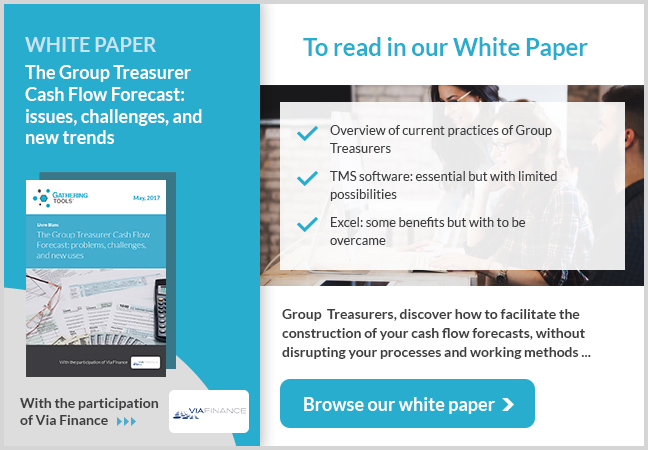Since you are reading this article, you are certainly one of the treasurers who use TMS (Treasury Management System) software. You also probably want to find solutions to overcome the current limitations of your TMS and optimize your daily activities. So here are some thoughts that will help you to be more effective in managing your cash flow.
Limit No. 1: standardization
 As a new corporate treasurer, you have decided to bring rigor and good practices into your company. To do this, you asked your management to invest in a market-leading TMS software (Kyriba, Sage or Diapason …). After extensive negotiations, management accepted your request.
As a new corporate treasurer, you have decided to bring rigor and good practices into your company. To do this, you asked your management to invest in a market-leading TMS software (Kyriba, Sage or Diapason …). After extensive negotiations, management accepted your request.
Problem: Since the integration of this new solution, obstacles have come your way. To stick to the financial “specificities” of your group, your integrator spent a few sleepless nights before finding acceptable answers. But in the end, it is still far from perfect.
Why? Because no treasurer has exactly the same profile. For example, budget control may be the responsibility of the treasurer, the accountant, the CFO or the controller, depending on the company. And we could give many other examples.
It is therefore understandable that the logic of standardization attached to any business software has no room for the specificities of a particular company.
Limit No. 2: functional coverage
 Your TMS software is excellent for managing your internal current accounts, interest scales or control of bank charges … In other words, everything concerning cash management strictly speaking.
Your TMS software is excellent for managing your internal current accounts, interest scales or control of bank charges … In other words, everything concerning cash management strictly speaking.
However, when it comes to establishing, for example, the cash flow statement or the change in balance sheet items, your TMS is absent. And that is normal! This is a consequence of the need for standardization attached to any business software described above. Some complex functionalities, very differently interpreted from one group to another, cannot be proposed in a simple management tool.
According to the latest AFTE report *, 36% of the treasurers surveyed believe that their TMS software does not allow for cash forecasting, 15% cash reporting, 11% exchange management and 6% debt management and monitoring. Difficult to develop the company’s cash policy under these conditions.
Thus, the functional coverage of your TMS may be suitable for 90% of your operations. But how do we handle the remaining 10%?
Limit No. 3: international
 In a large international group, subsidiaries are often left aside. If you are a Group Treasurer, you probably did not have (too much) trouble convincing the general management and the IT department of the advantage of using a TMS software. And at the head office, all your staff is now working with this new solution.
In a large international group, subsidiaries are often left aside. If you are a Group Treasurer, you probably did not have (too much) trouble convincing the general management and the IT department of the advantage of using a TMS software. And at the head office, all your staff is now working with this new solution.
But what about your subsidiaries and the data reporting that you’ve asked them for?
Two major issues arise at this level. The first one concerns the industry. The treasurer of your US subsidiary probably works very differently from his South American counterpart: He has neither the same culture, nor the same missions, nor the same constraints. Perhaps even these two subsidiaries have different sales scenarios, and therefore scenarios of different cash forecasts. How will you be able to force them to use the same TMS standard?
The second problem facing the subsidiaries is even more down to earth: We are talking about cost. Implementing TMS software (or even a simple web entry module) in 50 subsidiaries will require an enormous budget: costs of software licensing and maintenance, integration with local information systems, change support for all their staff …
Which solutions?
You already know the answer to that. Next to your TMS, you will inevitably have to build Excel processes; to cover certain cash management specificities within your group, to compensate for the missing functionalities and carry out all the tasks entrusted to you, or to organize the consolidation of financial data from your subsidiaries and partners.
But you know full well that setting up, monitoring and controlling these Excel processes can be very time-consuming. Worse: with the many users of your Excel workbooks, the editing and re-editing you will have to perform, and the total lack of traceability at this level, the errors in your data are likely to multiply.
And if we told you that we have a solution to make your Excel processes reliable, secure and fully integrated into your TMS and IS, would you believe us?






